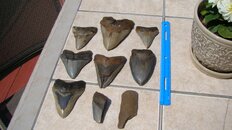- Messages
- 73
- Reaction score
- 0
- # of dives
- 0 - 24
Hi everyone.
I am going on my first Megladon Shark Teeth trip at one of the NC coast ledges this coming week. For those of you who have been before, what are the different search techniques used to find the teeth?
If any tools are required, I would like get them early this week prior to the trip.
Thanks!
I am going on my first Megladon Shark Teeth trip at one of the NC coast ledges this coming week. For those of you who have been before, what are the different search techniques used to find the teeth?
If any tools are required, I would like get them early this week prior to the trip.
Thanks!







